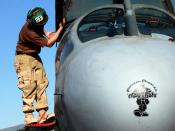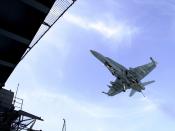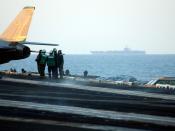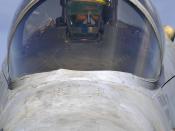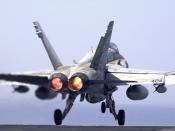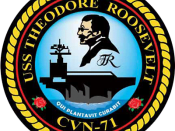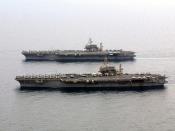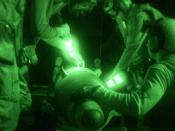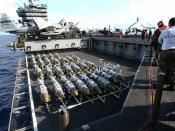U.S. Navy Carrier Aviation During the First Days of Operation Iraqi FreedomThe aircraft carrier is one of the most powerful tools the United States military has at its disposal. Its mere presence can serve to stabilize a region. In the days leading up to Operation Iraqi Freedom (OIF) not one but five aircraft carriers were positioned in the waters surrounding Iraq. Two were in the Mediterranean Sea to support operations in northern Iraq; they were the nuclear powered USS Harry S. Truman (CVN-75) and USS Theodore Roosevelt (CVN-71). The other three carriers were in the Persian Gulf to support southern operations. These were the venerable, conventionally powered USS Kitty Hawk (CV-63) and USS Constellation (CV-64) along with the nuclear powered USS Abraham Lincoln (CVN-72).
Each carrier is outfitted with more than fifty aircraft. The usual configuration consists of the following squadrons;, one E-2 Hawkeye, one SH-60B Seahawk, one EA-6B Prowler, one S-3 Viking, three FA-18C Hornet and, one F-14D Tomcat,.
The mission and role of each platform will be discussed further. The USS Abraham Lincoln was different; she was the first to deploy with the new FA-18E, single seat, Super Hornet. With increased range, weapons load and advanced avionics the Super Hornets maiden deployment would result in unparalleled combat successes.
The air war officially started on March 19, 2002. The carriers were already at work before this. To all intents and purposes, the air component was already at war by March 19. Aircrew had been flying hundreds of sorties per day since the first week of March (Grant, 2005, p. 130). The OIF air war consisted of five different components all functioning simultaneously. They were:Air dominance-"air superiority with SEAD (suppression ofEnemy Air Defenses), DEAD (Destroying Enemy Air Defenses),and DCA (Defensive Counter Air)Strategic attack-"A-Day played out all over the country"The West fight-counter Scud efforts, a "presidentialtasking"The North fight-helping Special Operations Forces (SOF)teams engage the Iraqi forces north of BagdadThe South fight-Support for the Army and Marines. TheSouth fight ultimately came to dominate sortie allocationand it drove requirements for carriers in the Persian Gulf.
(Grant, 2005, p. 133)The different carrier aircraft each had a specific role to play in each of these facets of the air campaign. The turbo-prop powered E-2 Hawkeye performs a role similar to an Air Force AWACS. It gives the carrier all weather airborne early warning capability and acts as an airborne command and control center. In Operation Iraqi Freedom, E-2 Hawkeye's provided critical airborne battle management and command and control functions supporting numerous close air support and battlefield air interdiction missions (PEOT, 2004). The SH-60B, the Navy version of the H-60 Blackhawk helicopter, as utilized by Helicopter Antisubmarine Squadron Four (HS-4) supported Navy SEAL, British Commando and Polish GROM forces in Kuwait and Iraq and were the primary force protection for the USS ABRAHAM LINCOLN Battle Group (HS-4, 2005). The SH-60 is also the Navy's primary Search and Rescue (SAR) platform, recovering aircrew downed at sea or any personnel that are unfortunate enough to fall overboard from a naval vessel. The S-3 Viking is traditionally used in anti-submarine warfare (ASW), but in OIF its main function was that of a tanker. One Viking from the Constellation was the first to be used for an overland strike in its 30-year history. It also was the first time the plane fired a laser-guided missile in combat (Santana, 2003). The EA-6B Prowler specializes in tactical electronic warfare. It makes use of the AGM-88 HARM anti-radiation missile in the SEAD mission, disabling enemy air defenses. It also possesses jamming and communications interception capabilities. In the early stages of Operation Iraqi Freedom (OIF), Navy Prowlers provided air defense suppression for both conventional and stealth aircraft, quickly shifting to a communications electronic attack focus once air defenses were defeated. The Prowler's flexibility in OIF provided the coalition with precise, tailored, and timely non-kinetic fires that disrupted, confused and disabled the enemy, enabling the swift defeat of the Hussein regime (Fitzgerald, 2004). The venerable but effective F-14D Tomcat performed superbly during OIF. Five squadrons operated this platform in the Strike, CAS, and DCA role. The Tomcat employed Laser guided Pave way series munitions as well as the GPS guided, Joint Direct Attack Munitions (JDAM). The Tomcat flew its last operational mission on February 8, 2006 aboard USS Roosevelt in its third OIF deployment. All F-14D squadrons in the Navy will either decommission or convert to the FA-18E/F Super Hornet. The FA-18C, single seat, Hornet performed the majority of attack missions by naval aircraft during OIF. The Hornet's payload consists of Laser guided munitions, JDAM, a 20MM cannon and a variety of Air-to-Air missiles. Hornets enjoyed great success and complete air superiority. One squadron, VFA-137's statistics from OIF is over 500 combat sorties and the expenditure of more than 300,000 pounds of precision-guided ordnance (VFA-137, 2005). The last and most significant of the carrier aircraft used in OIF is the FA-18E/F Super Hornet. On its maiden deployment with VFA-115 the Super Hornet has two variants the single seat E model, used for strike warfare and aerial refueling and the two-seat F model with its FAC-A capability. RADM Kelly, Commander Abraham Lincoln Carrier Battle Group found the Super Hornet so effective he brought forward two E's and two F's from USS Nimitz to add to VFA-115's 12 E's already onboard Lincoln (Grant, 2005, p. 164). "The Super Hornet provided organic tanking utilizing 6 of the 16 aircraft onboard in a four wing station drop tank, centerline Aerial Refueling Store (ARS) configuration, resulting in the transfer of 3.5 million lbs of fuel, generating 41 extra sorties a day between the three southern carriers from 19 March to 7 April. The other ten aircraft flew over 500 combat missions with a 100% combat sortie completion rate expending over 380,000 lbs of precision guided and conventional ordnance, in the Strike configuration", said Chief Warrant Officer (CWO3) Stephan Varga, the Weapons Officer, from VFA-115 during its participation in OIF (CWO3 S. Varga, personal communication February 27, 2005). The Super Hornet has the ability to carry four 2000 lb JDAM in addition to its Air-to-Air armament, where the C model Hornet can carry only two JDAM with no Air-to-Air missiles. The FA-18E/F proved their operational suitability and effectiveness (Grant, 2005, p. 164).
The air wings assigned to USS Kitty Hawk ((CV-63) with CVW-5 embarked), Constellation ((CV-64), CVW-2), Abraham Lincoln ((CVN-72), CVW-14), Theodore Roosevelt ((CVN-71), CVW-8) and Harry S. Truman ((CVN-75), CVW-3) demonstrated the overpowering might of carrier aviation that represents the hard work of the past 12 years to keep Naval Aviation at the tip of the spear (Fitzgerald, 2003). The overall total for OIF was impressive. From March 20 to April 12, 2003 aircraft flying from our carriers flew over 7,000 sorties as part of the air component command power projection mission (Grant, 2005, p. 172). The five carriers had more than fulfilled their contracts. They had demonstrated the ability to wage five different wars, calling on everything from high-altitude JDAM strikes to low level strafing in support of ground troops proving the effectiveness of U.S. Navy carrier aviation.
ReferencesGrant, R. (2005). Battle-Tested; Carrier Aviation inAfghanistan and Iraq. Washington, D. C.: IRIS PressHS-4 Command History (2005, June 21). Retrieved March 7, 2005 from the World Wide Web: http://www.hs4.navy.mil/CommandHistory/cmdhist.htmProgram Executive Office for Tactical Aircraft Public Affairs (PEOT) Release (2004, Aug, 25). E-2 Hawkeye surpasses 1 Million Flight Hours. Retrieved March 4, 2005 from the World Wide Web: http://www.news.navy.mil/search/print.asp?story_id=14885&VIRIN=16237&imagetype=1&page=1Santana, N. (2003, June 1). Red Griffins go out in a blaze of glory. Retrieved March 4, 2005 from the World Wide Web: http://www.signonsandiego.com/news/military/20030601-9999_1m1return.htmlStatement by RADM Fitzgerald, M. P (Deputy Chief of Naval Operations). (2004, March 3). Navy Capabilities for Conducting Conventional Long Range Strike. Retrieved March 4, 2005 from the World Wide Web: http://www.globalsecurity.org/military/library/congress/2004_hr/040303-fitzgerald.htmVFA-137 Command History. Retrieved March 5, 2005 from the World Wide Web: http://www.lemoore.navy.mil/vfa-137/HISTORY_PAGE.htmStatement by RADM Fitzgerald, M. P (Deputy Chief of Naval Operations). (2003). Operation Iraqi Freedom: The Payoff. Retrieved March 5, 2005 from the World Wide Web: http://www.tailhook.org/Br2Wi03.htm
